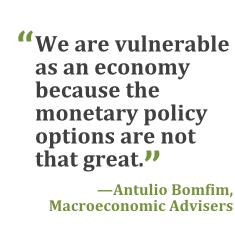The Federal Reserve Board's army of economists are the ultimate umbrella people: They prepare for rain on sunny days.
Even though no Federal Open Market Committee (FOMC) member has forecast a recession in the next three years, a shaky global environment has clouded the U.S. economic outlook. With the central bank's main policy rate stuck at zero since December 2008, that means Fed staff is probably already mulling other ways to stimulate growth.
Here are three tools at Fed policy makers' disposal—along with their benefits and drawbacks.
1. More forward guidance.
What: The Fed could offer more hints to investors about when it will raise rates and at what speed. If those communications suggest policy makers will raise rates more slowly than investors had previously expected, borrowing costs could decline, which may spur borrowing and spending.
 Pro: This is the easiest option because it costs nothing, and it was also the last tool the Fed used to squeeze extra stimulus out of its current zero-rate policy.
Pro: This is the easiest option because it costs nothing, and it was also the last tool the Fed used to squeeze extra stimulus out of its current zero-rate policy.
Con: The punch from this stimulus could be limited because short-term yields, the place where the Fed can most credibly guide investors on rates, are already low. The U.S. Treasury's 3-year note yields just 0.90 percent.
“The market is not going to need any forward guidance if there is a recession and 2-, 3-, and 4-year rates are down to zero,” says Roberto Perli, a partner at Cornerstone Macro LLC in Washington and former member of the Fed's Division of Monetary Affairs.
2. More QE.
What: The Fed could buy more bonds in a policy known as quantitative easing (QE).
Pro: It is very effective in a financial crisis, according to researchers such as Joseph Gagnon at the Peterson Institute for International Economics in Washington. He and his co-authors in a report found ”economically meaningful and long-lasting reductions in longer-term interest rates” in the last rounds of quantitative easing.
Cons: In a recession where financial stress isn't the main feature, bond purchases may be less effective. Even longer-term bond yields are already low, so there's not much to be gained. The U.S. 10-year note yields about 2 percent today, compared with 3.11 percent when the central bank began purchasing bonds outright in 2008. There are also the potential complications of exiting a balance sheet that swelled to $4.5 trillion from previous rounds of QE. The political blowback in a Republican-controlled Congress, where QE was never popular, could cause more headaches for the central bank.
3. Negative interest rates.
What: The Fed could lower its main policy rate below zero, something it has never done. The target rate is currently at between zero and 0.25 percent.
Pros: Countries like Sweden have started to experiment with this, and there doesn't seem to be a lot of financial instability associated with it. It could weaken the dollar against other major currencies, which would help American exporters. Faced with having to pay a bank to hold their money, depositors may choose to take on more risk by shifting funds into assets with longer maturities, pushing down interest rates further along the yield curve. They could also end up spending more money.
The idea has support from at least two regional Fed bank presidents: Naryana Kocherlakota of Minneapolis and John Williams of San Francisco.
Cons: The U.S. financial system is more diverse than Europe's. The American banking system is populated with thousands of community banks that rely almost solely on depositors for loanable funds.
A migration away from small banks into zero-yielding products—cash, debit cards, or money-market funds that might find a way to keep returns less negative than a bank deposit—could disrupt credit creation. That would defeat the purpose of the policy.
“Individuals expect a return for parking their money in a local bank,” said Paul Merski, chief economist for the Independent Community Bankers of America in Washington. “The lower that return, the less lending” if deposits migrate.
The goal of investment in short-term assets, says Joseph Abate, a money market strategist at Barclays in New York, becomes “losing less money,” and the distortions that creates may not be worth the trouble.
“You are really entering a point where fiscal policy is called for,” Abate says. “You have reached the end-point of sensible monetary policy.”
The Bottom Line
The Fed doesn't have very many good options, and that is why Fed officials such as Lael Brainard are arguing that the downside risks of raising interest rates too soon are larger than the risks of being too late and triggering faster inflation in the future. The Fed knows how to fight inflation.
“We are vulnerable as an economy because the monetary policy options are not that great,” said Antulio Bomfim, senior managing director at Macroeconomic Advisers LLC.
© 2025 ALM Global, LLC, All Rights Reserved. Request academic re-use from www.copyright.com. All other uses, submit a request to [email protected]. For more information visit Asset & Logo Licensing.




